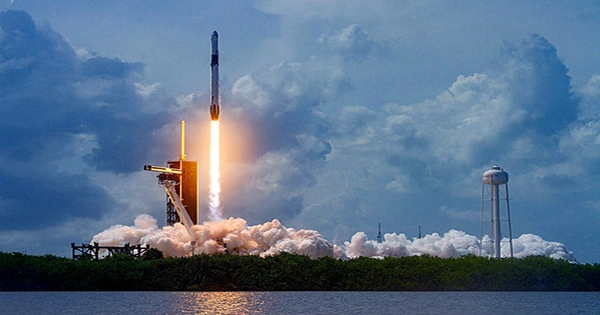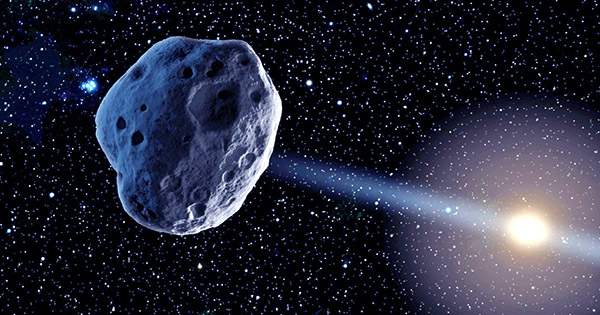Scientists researching a nearby protostar discovered water in its circumstellar disk. The latest measurements, made with the Atacama Large Millimeter/submillimeter Array (ALMA), are the first to show that water may be carried into a protoplanetary disk without causing significant changes in its composition. These findings support the theory that water in our Solar System formed billions of years before the Sun.
V883 Orionis is a protostar in the constellation Orion situated approximately 1,305 light-years from Earth. The latest observations of this protostar have assisted scientists in confirming a possible relationship between the water in the interstellar medium and the water in our Solar System.
“We can think of the path of water through the Universe as a trail. We know what the endpoints look like, which are water on planets and in comets, but we wanted to trace that trail back to the origins of water,” said John Tobin, an astronomer at the National Science Foundation’s National Radio Astronomy Observatory (NRAO) and the lead author on the new paper.
“Before now, we could link the Earth to comets, and protostars to the interstellar medium, but we couldn’t link protostars to comets. V883 Ori has changed that, and proven the water molecules in that system and in our Solar System have a similar ratio of deuterium and hydrogen.”
Observing water in circumstellar disks around protostars is difficult since water is usually present in the form of ice in most settings. When scientists watch protostars, they are looking for the water snow line or ice line, which is the point at which water transforms from primarily ice to gas and may be observed in detail by radio astronomy.
“If the snow line is located too close to the star, there isn’t enough gaseous water to be easily detectable and the dusty disk may block out a lot of the water emission. But if the snow line is located further from the star, there is sufficient gaseous water to be detectable, and that’s the case with V883 Ori,” said Tobin, who added that the unique state of the protostar is what made this project possible.
We have shown that water that is produced in the clouds follows this trail virtually unchanged. So, by looking at the water in the V883 Ori disk, we essentially look back in time and see how our own Solar System looked when it was much younger. Until now, the chain of water in the development of our Solar System was broken. V883 Ori is the missing link in this case, and we now have an unbroken chain in the lineage of water from comets and protostars to the interstellar medium.
John Tobin
V883 Ori’s disk is quite massive and is just hot enough that the water in it has turned from ice to gas. That makes this protostar an ideal target for studying the growth and evolution of solar systems at radio wavelengths.
“This observation highlights the superb capabilities of the ALMA instrument in helping astronomers study something vitally important for life on Earth: water,” said Joe Pesce, NSF Program Officer for ALMA. “An understanding of the underlying processes important for us on Earth, seen in more distant regions of the galaxy, also benefits our knowledge of how nature works in general, and the processes that had to occur for our Solar System to develop into what we know today.”
To connect the water in V883 Ori’s protoplanetary disk to that in our own Solar System, the team measured its composition using ALMA’s highly sensitive Band 5 (1.6mm) and Band 6 (1.3mm) receivers and found that it remains relatively unchanged between each stage of solar system formation: protostar, protoplanetary disk, and comets.
“This means that the water in our Solar System was formed long before the Sun, planets, and comets formed. We already knew that there is plenty of water ice in the interstellar medium. Our results show that this water got directly incorporated into the Solar System during its formation,” said Merel van ‘t ‘Hoff, an astronomer at the University of Michigan and a co-author of the paper. “This is exciting as it suggests that other planetary systems should have received large amounts of water too.”
Clarifying the function of water in the formation of comets and planetesimals is crucial to understanding how our own Solar System formed. Although the Sun is thought to have formed in a crowded cluster of stars, and V883 Ori is comparatively isolated with no surrounding stars, the two have one essential feature: they both evolved in huge molecular clouds.
“It is known that the bulk of the water in the interstellar medium forms as ice on the surfaces of tiny dust grains in the clouds. When these clouds collapse under their own gravity and form young stars, the water ends up in the disks around them. Eventually, the disks evolve and the icy dust grains coagulate to form a new solar system with planets and comets,” said Margot Leemker, an astronomer at Leiden University and a co-author of the paper.
“We have shown that water that is produced in the clouds follows this trail virtually unchanged. So, by looking at the water in the V883 Ori disk, we essentially look back in time and see how our own Solar System looked when it was much younger.” Tobin added, “Until now, the chain of water in the development of our Solar System was broken. V883 Ori is the missing link in this case, and we now have an unbroken chain in the lineage of water from comets and protostars to the interstellar medium.”
















